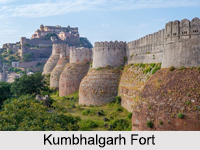 With the Aravalli Ranges as an enchanting backdrop, the Kumbhalgarh Fort is considered to be the second most important citadel in the Mewar region. Located about 85 km from the city of Udaipur in the Rajsamand district in western India, the Kumbhalgarh Fort is a World Heritage Site and is under the group Hill Forts of Rajasthan.
With the Aravalli Ranges as an enchanting backdrop, the Kumbhalgarh Fort is considered to be the second most important citadel in the Mewar region. Located about 85 km from the city of Udaipur in the Rajsamand district in western India, the Kumbhalgarh Fort is a World Heritage Site and is under the group Hill Forts of Rajasthan.
History of Kumbhalgarh Fort
Constructed during the course of the 15th century by Rana Kumbha, the erstwhile ruler of Mewar, the Kumbhalgarh Fort was occupied until the 19th century but is now open to the public. Kumbhalgarh in its present form was believed to have been designed by a famous architect of the era Madan. Under the rule of King Rana Kumbha, the kingdom of Mewar stretched right from Ranthambore to Gwalior and included vast tracts of Madhya Pradesh as well as Rajasthan. Since the ancient times, there have been about 84 fortresses defending Mewar from its enemies. Out of these 84, Rana Kumbha, himself, has designed about 32 of them, out of which the Kumbhalgarh Fort has been the most impressive, famous and the massive one with a wall stretching for about 32 km. The mighty fort stands at an elevation of 3,600 ft and is a testament to the valour and indomitable spirit of the Rajputs. The fort"s strategic position atop a high ridge camouflaged by the surrounding peaks has made it one of the most important and probably the only impregnable fort of the state. Though never conquered in battle, it was captured only once by the Mughal army by deceit when they poisoned the water supply of the fort. Being the birthplace of the legendary Maharana Pratap Singh, the Kumbhalgarh fort also holds a very special place in history and in the hearts of the Rajputs.
Architecture of Kumbhalgarh Fort
The well defined architectural features of the Kumbhalgarh Fort have made it an invincible stronghold of Rajput supremacy. Towering loftily above, the sturdy rounded bastions are the first thing that the tourists notice while entering the fort. The Kumbhalgarh Fort has 7 fortified gateways called Pols, guarding all the possible entries to the fort. The ramp inside the fort leading up to the top of the hill has many sharp turns, made intentionally to make it difficult for enemy army with elephants and horses to proceed fast. There are also clever traps built at many places to take the enemy by surprise.
Structures in the Kumbhalgarh Fort
There are over 360 temples within the fort, 300 ancient Jain and the rest Hindu. The most significant and revered temples is the Neelkanth Mahadev Temple, dedicated to Lord Shiva. With its huge round dome, intricately carved ceiling aloft 24 pillars, the wide courtyard and 5-feet high lingam, the temple is an unmatched architectural feat. The idol of Shiva is made of black stone and is depicted with 12 hands. The inscriptions indicate that the temple was renovated by Rana Shanga.
Then there are the Jain temples of Parsva Natha, Bawan and Golera, which are quite popular Jain Temples within the fort. Other than these, there is the Mataji temple also known as Kheda Devi, which is located on the southern side of the Neelkanth Temple. There is also the Lakhola Tank inside the fort premises, which was constructed by Rana Lakha during 1382 to 1421 CE. It is located on the western side of the Kelwara town and had a depth of about 40 ft during independence and since then has been raised to 60 ft.
Culture of Kumbhalgarh Fort
Organized by the Rajasthan Tourism Department, there is a three day annual festival in the fort in remembrance of the passion of Maharana Kumbha towards art and architecture. With the fort as the background, sound and light shows are organized along with various concerts and dance events are arranged to commemorate the function. Few of the important events during the festival are Heritage Fort Walk, turban tying, tug-of war and mehendi mandana among others.
Visiting Information on Kumbhalgarh Fort
The nearest railway station is the Udaipur station at a distance of 100 km from the Kumbhalgarh Fort, and the Maharana Pratap Airport is the closest at a distance of 98 km.



















